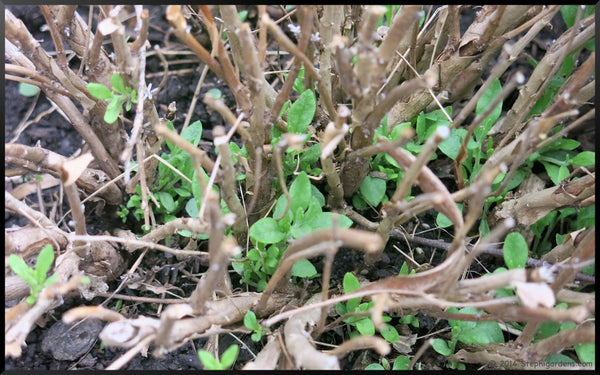Seasonal Lavender Plant Care: Spring
Check out our video playlist of springtime lavender garden chores at the bottom of this page!
Although we still have snow on the ground here in Seafoam, NS, with all the coronavirus chaos in the world right now, we are eager to garden at the first available opportunity for a safe and peaceful outdoor activity.
There are several important plant care activities to do during the spring to prepare for the best possible growing season and flowering season of your lavender plants!
1: How do I know if my plant survived the winter?
If you have lavender plants that are hardy in your growing zone (see our Lavender 101 post for more information on this), it is likely that they will return year after year for a decade or two. But even the toughest perennials may still look quite grisly after their long winter dormancy. A live, but dormant, lavender plant is usually a silvery colour, tinged with green.
As warm weather and the sun approach, new, bright green growth will start emerging from the woody stems. It may be at the base of the plant where it can be easily missed. In Nova Scotia, it may be as late as the end of June before the plants ‘come back to life!’

One of our greatest heartaches is when people send us photos of their ‘dead’ lavender plants that they’ve taken out of the ground too early. Often these plants are, in fact, still alive. So, be patient and give them a chance to come back! One sign of living, dormant plants is when the stems are flexible and can be gently bent but don’t break. If you really wish to be sure that your plant is alive, you can use a thoroughly cleaned knife or pair of garden shears to cut a stem. Green inside = alive! In colder climates, it sometimes takes until mid- to late June for your plants to come out of winter dormancy. Patience, please! :)
One of the joys of growing lavender in Nova Scotia is that, since they are late to grow back, they also bloom late through the summer! Our peak bloom is in mid-July, but we frequently have at least a few flowers well into the fall.
2: Pruning. It isn't necessary to prune lavender for the health of the plant. If you forget to prune or chose not to prune, the plant will be just fine. They are very forgiving plants -- in fact, many people kill their lavender by pruning too much or at the wrong time of year. In colder climates, we recommend pruning anytime in the month of May -- never in the fall. (To clarify, you can "deadhead" -- remove spent lavender blossom stalks -- any time, but save significant pruning of the plant itself until the month of May.) For detailed pruning instructions - see our Pruning blog post!
3: Weeding
While we love leaving weeds and wildflowers between our lavender rows (they feed the bees, help retain topsoil, and provide hiding places for beneficial insects), too many too close to your plants can restrict their growth. We recommend clearing a patch around the base of your lavender plants that is as large around as the crown of the plant itself. A great way to help prevent weeds from returning is to put unbleached paper (like brown paper bags, corrugated cardboard, or brown butcher paper) over the soil, and then cover with a bark mulch.
4: Soil maintenance
Alright, let’s talk soil! Lavender is a very picky plant when it comes to soil conditions. Lavender requires good drainage as soggy roots will kill your plant. The roots also have a high oxygen demand and need loose soil with lots of air spaces. The method for achieving these conditions will depend upon what soil type you have:
| Soil Type: | Characteristics: | Soil amendment requirements: |
| Sandy or chalky | Good drainage, low organic material content | Add organic material (compost) |
| Clay, silty, or peaty | Poor drainage and high water retention | Till in large pieces of bark mulch to provide air spaces. Supplement bark mulch regularly (every other year or so). Peaty soil is also highly acidic and will need pH correction - see info on pH below. |
| Loamy soil | Good drainage and high organic material content | You’ve hit the jackpot! Your soil type is perfect! |
Lavender requires a neutral to slightly alkaline pH. On our shore, we have extremely acidic soil, which is hostile to lavender growth. We supplement our soil annually with pelletized lime (~1 cup per fully grown plant) in early Spring to bring the pH to neutral. If you’re not sure what your soil pH is, you can purchase pH test kits at your local hardware or garden store and check!
Additionally, for optimum flower production, you’ll want to fertilize a little bit. You can give each plant a small amount (2 cups or so) of well-aged compost early in the spring, or sprinkle a small amount (1-2 tsp per plant) of some pelletized slow-release fertilizer with a balanced nutrient ratio (e.g. 7-7-7).
We hope this springtime guide helps you achieve the best year of lavender plant growth ever! If you’re in Nova Scotia or another cold climate, we are still a few months away from the plants greening up, but it’s well worth the wait!
Check out our video playlist of springtime lavender garden chores:
Cover photo credit: Natalia Luchanko; all other photos and video © Kiva-Marie Belt / Seafoam Lavender Farm, Ltd.















